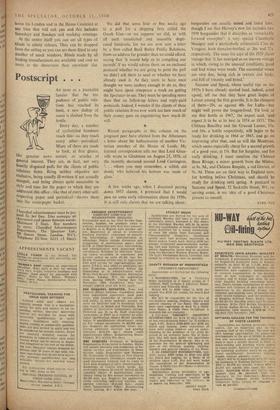Postscript . .
As soon as a journalist fancies that the im- pudence of public rela- tions has reached its limit, a new dollop of sauce is sloshed from the bottle.
Every day, a number of cyclostyled handouts reach this—as they reach every other—periodical.
Many of them are made to look, at first glance, like genuine news stories, or articles of general interest. They arc, in fact, not very heavily disguised pulls for the clients of public relations firms. Being neither objective nor exclusive, being usually ill-written if not actually Misspelt, and being always quite unsuitable in style and tone for the paper to which they are addressed, this office—like that of every other self- respecting paper and periodical—throws them into the waste-paper basket. NiVe did that some four or five weeks ago to a puff for a shipping firm called the Greek Line—or we suppose we did, as with all such unsolicited and unusable dupli- cated handouts; for we are now sent a letter by a firm called Basil Butler Public Relations, from an address far grander than we could afford, saying that 'it would help us in compiling our records' if we would advise them on an enclosed postcard whether we are going to print the puff we didn't ask them to send or whether we have already used it. As they seem to have once thought we were suckers enough to do so, they might have spent ninepence a week on getting the Spectator to sec. They must be spending more than that • on follow-up letters and reply-paid postcards. Indeed, 1 wonder if the clients of these public relations firms ever work out how much of their money goes on engendering how much ill- will.
*
Recent paragraphs in this column on the pregnant peer have elicited from the Athenzeum a letter about the hallucination of another Vic- torian member of the House of Lords. My learned correspondent tells me that Lord Gran- ville wrote to Gladstone on August 25, 1876, of the recently deceased second Lord Carrington, . . whom you may remember, a selfish old dandy who believed. his bottom was made of glass.'
A few weeks ago, when I discussed putting down 1957 clarets, I promised that I would pass on some early information about the 1959s. It is still only clarets that we are talking about : burgundies are usually tasted and listed later, though I see that Harvey's new list includes two 1959 burgundies that it describes as 'remarkably forward examples': a very. special Chambolle Musigny and a particularly aristocratic Clos de Vougeot, both domaine-bottled, at 26s. and 27s. respectively. The same list says of the 1959 claret vintage that 'it has emerged.as an uneven vintage in which, owing to the unusual conditions, good and bad wines were made. The successful wines are very fine, being rich in texture and body, and full of vinosity and breed.'
Saccone and Speed, whose useful tips on the 1957s I have already quoted (and, indeed, acted upon), tell me that they have great hopes of Latour among the first growths. It is the cheapest of them-29s. as against 40s. for Lafitc—but might well prove the longest-lived. Td look at my first bottle in 1967,' the expert said, 'and expect it to be at its best in 1974 or 1975.' The Château Batailley and the Gruaud Larose, 15s. and 16s. a bottle respectively, will begin to be ready for drinking in 1964 or 1965, and go on improving after that, and so will the Montrose, which seems especially cheap for a second growth of a good year, at 15s. But for bargains, and for early drinking, 1 must mention the Château Beau Rivage, a minor growth from the Medoe, at 8s. 9d., and Château Respide, a red Graves, at 9s. 9d. These are on their way to England now, for bottling before Christmas, and should be ready for drinking next spring. A postcard to Saccone and Speed, 32 Sackville Street, WI, re- 'serving some, is my idea of a good Christmas present to oneself.
CYRII 121Y


















































 Previous page
Previous page